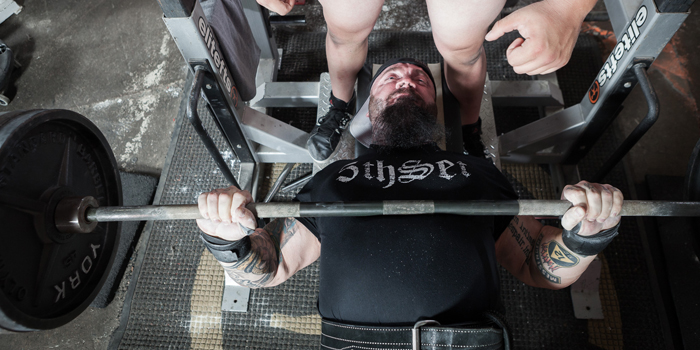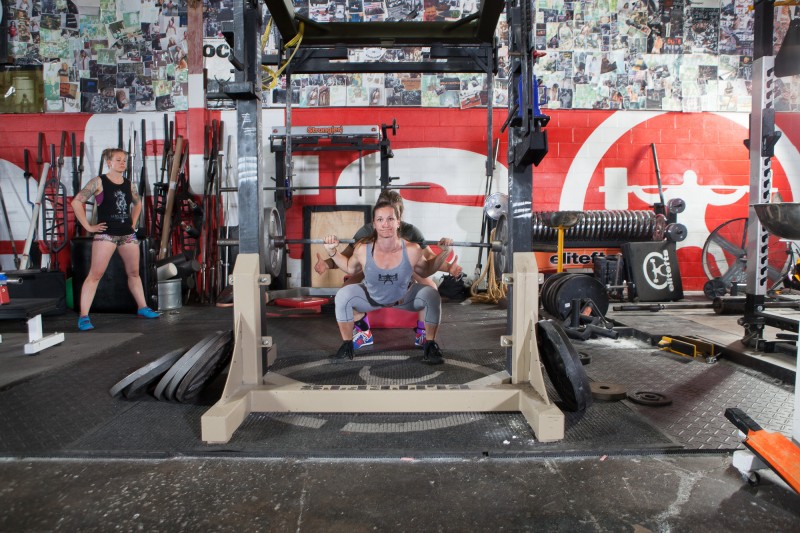
This is Part 2 of a series on my take on conjugate, Westside, concurrent, or whatever the heck everyone is calling it these days. What I am talking about is the four-day per week rotation consisting of two max effort days and two dynamic effort days developed and popularized by Louie Simmons. There are many articles on elitefts about this method. This is my interpretation, adaptation, and application of it.
- Part 1: 4 Max Effort Method Principles to Master
- Part 3: 5 Repeated Effort Method Principles to Master
- Part 4: The Big Picture of Conjugate
Speed work — that's what most people end up calling it. Although speed is an important component of dynamic effort training, the truth is that you are not necessarily training to be faster. You are training to produce more force, recruit more muscle fibers, and do both in as short of time frame as possible (when these happen the bar is going to move faster).
The idea behind dynamic effort training is that through compensatory acceleration (trying really hard to move the bar really fast), you can apply a maximal force to a submaximal weight. According to Isaac Newton's second law, the force (F) exerted on an object is directly proportional to its mass (m) and acceleration (a), or F=ma.
RECENT: 4 Max Effort Method Principles to Master
If you want to produce big force in the gym, you can either grind against large mass without a whole lot of acceleration (think of what a typical third attempt looks like), or you can have smaller mass and put all of the acceleration you can on it. On dynamic effort day, we are shooting for the side of the scale with really big acceleration, small mass, and big force.
Lifters get hung up on how much weight they are moving, how many bands or chains they use, or whether or not they’re training strength-speed or speed-strength. When they get hung up on these things, they end up missing the point of dynamic effort work altogether.
What do you need to worry about? How heavy do you need to go? How many sets should you do? How many reps? What about accommodating resistance?
The following principles will help you answer those questions:

Principle 1: Acceleration is the Intention
If you are training to produce more force, your intention must be to produce as much force as possible on a given rep. As I mentioned above, in order to do this, you need to maximize acceleration. You can't just go through the motions on dynamic effort work and expect to get results. Even if the bar is moving fast, if you aren't putting everything you have into it, you won't be getting a maximal contraction. You won't be producing maximal force and you won't be getting the desired training effect.
The bar shouldn’t be moving fast just because it is light. It should be moving fast because there’s no other option. Treat every rep of dynamic effort work with the intensity you would a max single. Blow that thing up and reap the rewards.
Principle 2: You Can't Pitch a Wiffle Ball (or a Shot Put)
The loading has to be appropriate. If the bar is too light, you won't be able to put any force into it. If the bar is too heavy you will fatigue towards the end of your sets and won’t be producing maximal force. The right weight is somewhere in the middle, but it will take some trial and error to figure out.
What is a good starting point? A general place to go would be 50 percent for eight to ten sets of two to three. Once you've played with things and get the feel for what a snappy rep feels like, you can start experimenting with the loads you are using. People have had success with 30 to 40 percent, while others have with 60 to 70 percent. There is no hard rule on what percentages to use as long as you are putting everything you can into that bar, and bar speed is maintained throughout your sets.
Typically, more experienced lifters can get more out of lighter percentages, while newer lifters need to use heavier loads to get enough stimulus. The more experienced a lifter, the better they will be at getting muscle fibers to fire, so they can get away with using lighter weights.
LISTEN: Table Talk Podcast Clip — Why Do You Focus on Compound Lifts Over Isolation Lifts?
Principle 3: Don't Overdo the Volume
How much volume you should be hitting on dynamic effort days? Enough to generate a stimulus but not so much that you are no longer training dynamically. You shouldn’t need to stray too far from the old-school calling of 8-12x2 for squatting, 8-12x3 for benching, and 8-12x1 for deadlifting.
Why? Too many sets, and your acceleration will decrease and so will the desired training effect. Too many reps per set, and the bar won’t be moving the same from the first to the last rep. Too few sets, and you won't achieve an adequate stimulus.
If you find you are beaten up after dynamic effort day, that's a sign that your volume is a bit too high. If you find that by the end of your sets you feel like you haven't done a whole lot, either your volume is too low or you aren't putting enough effort into each rep.
I'd rather err on the side of too little volume on dynamic effort day than too much. If you are in doubt consult, Prilepin's Chart.

Principle 4: If You Are Going to Use Accommodating Resistance, Use It Right
Accommodating resistance in the form of bands and chains is often used on dynamic effort day. Whether or not you add a band isn't going to make or break dynamic effort day, but there are a few ways bands and chain play into dynamic effort’s application.
Mainly, accommodating resistance will make a rep heavier at the top and lighter at the bottom. When the bar gets heavier at the top, it forces the lifter to generate force through an entire rep. They don't have the option to back off toward lockout; instead, they have to drive through the added resistance from top to bottom.
Where lifters go wrong with accommodating resistance is in the setup: chains that never deload, bands that go slack at the bottom, tension that never ramps up, and either using way too much tension or not enough to make a difference. If you are going to take the time to set up bands or chains, it is worth the time to look up doing it properly.
It should be noted that if you are adding accommodating resistance, the weight on the bar is going to have to be reduced accordingly.
Principle 5: Practice Makes Perfect
With typical dynamic effort work, you are getting a lot of first reps. Why are first reps important? In a meet, you only get one rep per attempt, so being able to execute on one rep becomes pretty damn critical.
Dynamic effort training allows you to get a whole lot of chances to practice setting up, getting tight, and being aggressive with that first rep. The weight isn't maximal, so the consequences of error aren't as high, but that is no excuse to not take each rep as seriously as possible. This repetition is where you can form good habits. This is where you can perfect setup, perfect your mental approach, and ingrain these into your mind so that when it comes time to do so on the platform, you are on autopilot.
READ MORE: The Mind-Muscle Link: Learn Muscle Attachments
In Conclusion
As I said before, conjugate is one of, if not, the most effective training systems when it is executed properly. Moving a light weight fast isn't enough to make the dynamic effort method work. Moving a light weight fast with intention is. Your intention is what will make the biggest difference on dynamic effort day. If you are moving the bar as you should be, you’ll be getting more right than wrong.
Seth Albersworth is a powerlifter with experience in and out of gear. His best totals are 2,000 pounds raw and 2,403 pounds multi-ply. Seth has completed his bachelor's degree in kinesiology from the University of Calgary and is currently studying to become a Doctor of Chiropractic at Palmer College of Chiropractic's Florida Campus.











I see some coaches telling athletes that all 3 reps should be performed in the same amount of time as 1 ME rep.
I also see some athletes slowing it down a bit on the loading portion then exploding as fast as they can on the upward part of the movement.
Are there benefits or drawbacks to either method? Are either superior?
I see way too many people rushing the eccentric, getting sloppy, and than turning that into a sloppy concentric. It's not a race to get to the bottom.
As to the question of rotation of dynamic day exercises, just speaking from my past nationals training I did rotate speed days specifically in the deadlift. In strongman I had various deadlift heights, 18 inches, 12 inches, axel deadlift, floor deadlift. This developed an issue quickly as I practiced these lifts. Different start positions by bar heights, different sticking points, different weaknesses in my back positioning. I found it extremely helpful to rotate speed exercises. Example would be 12 inch speed into a ssb max effort squat same week. 18 inch max effort dead speed box squat in a week. Many variations all dependent on my own current weaknesses. Hope this helps. Granted I am only a National level strongman competitor but trial and error, school, and outside sources of research has lead me to this conclusion. Hope it provides some insight.